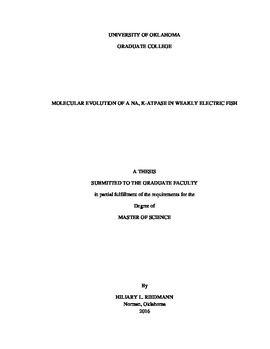| dc.description.abstract | African mormyrids and South American gymnotiforms are two independently evolved lineages of weakly electric fish that produce electric organ discharges (EODs) as sensory and communication signals. EOD frequency varies across species, ranging from less than 10 Hz to more than 2000 Hz. EODs are the summed action potentials generated by electrocytes, specialized electrically excitable cells of the electric organ. The Na+ currents that depolarize the electrocyte during the action potential can exceed 10 microamperes, several orders of magnitude larger than Na+ currents in other excitable cells such as neurons and myocytes. The Na, K-ATPases expressed by electrocytes must re-establish the necessary ionic gradients in the interval between action potentials by the active transport of K+ and Na+. This interval decreases as EOD frequency increases, becoming less than one millisecond at EOD frequencies above 500Hz and creating significant demands for rapid transport on the Na, K-ATPase. Because the voltage-gated Na+ channels responsible for producing the EOD have undergone molecular evolution driven by positive selection in both the mormyrids and gymnotiforms, I examined the Na, K-ATPase α2 subunit for evidence of a similar pattern of positive selection. I further hypothesized that increased positive selection occurred within lineages that emit higher frequency EODs. I found evidence for positive selection acting on the Na, K-ATPase α2 subunit of gymnotiforms with both low and high frequencies, while purifying selection occurred within the mormyrid lineage. Eighteen amino acid sites within functionally important regions of the Na, K-ATPase protein were identified as possibly under positive selection and therefore of interest in future studies aimed at determining the functional consequences of molecular evolution in the Na, K-ATPase. | en_US |
